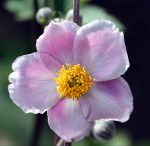 Earlier to flower and hardier than other Japanese anemones, this herbaceous perennial is native to open grassy slopes in northern China. Also known as windflower, it is a member of the buttercup family, Ranunculaceae, that also includes delphinium, clematis, and hellebore. Plants grow from a fibrous root system and form a clump of basal foliage up to 2′ tall. Each dark green leaf is 10-12″ long, palmately divided into three-lobed and toothed leaflets that are thickly covered with woolly whitish hairs on their underside. Stems are also covered with whitish woolly hairs. From late summer to early fall, cup-shaped flowers appear on 3-4′ long wiry stems. Each flower is 2-3″ wide and has a center of yellow stamens surrounded by 5 or 6 showy tepals that are pale pink with darker rose shadings. A good choice for borders, and informal landscapes such as cottage and woodland gardens. Flowers are good in the vase. The genus name, Anemone, is probably a corrupted Greek loan word of Semitic origin referring to the lament for the slain Adonis or Naaman, whose scattered blood produced the blood-red Anemone coronaria. The specific epithet, tomentosa, is the Latin word meaning densely woolly, and refers to the hairs on the stems and leaf undersides.
Earlier to flower and hardier than other Japanese anemones, this herbaceous perennial is native to open grassy slopes in northern China. Also known as windflower, it is a member of the buttercup family, Ranunculaceae, that also includes delphinium, clematis, and hellebore. Plants grow from a fibrous root system and form a clump of basal foliage up to 2′ tall. Each dark green leaf is 10-12″ long, palmately divided into three-lobed and toothed leaflets that are thickly covered with woolly whitish hairs on their underside. Stems are also covered with whitish woolly hairs. From late summer to early fall, cup-shaped flowers appear on 3-4′ long wiry stems. Each flower is 2-3″ wide and has a center of yellow stamens surrounded by 5 or 6 showy tepals that are pale pink with darker rose shadings. A good choice for borders, and informal landscapes such as cottage and woodland gardens. Flowers are good in the vase. The genus name, Anemone, is probably a corrupted Greek loan word of Semitic origin referring to the lament for the slain Adonis or Naaman, whose scattered blood produced the blood-red Anemone coronaria. The specific epithet, tomentosa, is the Latin word meaning densely woolly, and refers to the hairs on the stems and leaf undersides.
Type: Herbaceous perennial
Bloom: Pink with darker shading from late summer into fall
Size: 2-4′ H x 2-3′ W
Light: Part shade to full sun
Soil: Average, consistently moist, well-drained
Hardiness: Zones 4-7
Care: May need staking
Pests and Diseases: Generally healthy but susceptible to leaf spot, powdery mildew, downy mildew, rust, leaf/stem smut, caterpillars, beetles, slugs and nematodes.
Propagation: Root cuttings in winter, division in spring, seed
Companion Plants: Maiden grass (Miscanthus), Joe pye weed, coneflower ‘White Swan’, Verbena bonariensis
Photo Credit: Wikimedia Commons